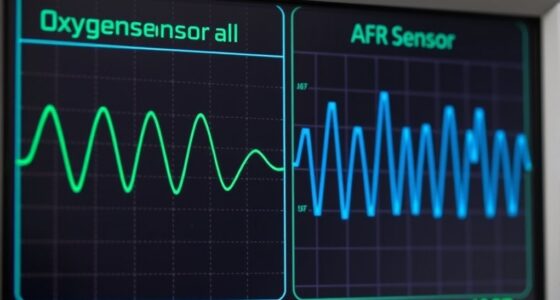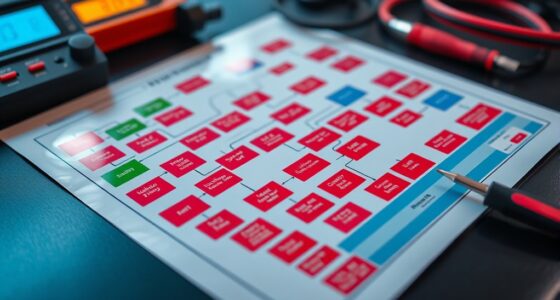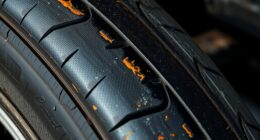When you get an OBD-II code, start by noting the letter and four digits to identify the system and specific problem, like P0171 for a fuel system issue. Use an OBD-II scanner to retrieve the code from your vehicle’s computer, then interpret it based on the system—powertrain, body, chassis, or network. Properly diagnosing whether sensors or other components are faulty helps you make accurate repairs. Keep reading to uncover tips on decoding and acting on these codes effectively.
Key Takeaways
- Use an OBD-II scanner to read diagnostic trouble codes displayed on the vehicle or scanner screen.
- Understand code structure: a letter (P, B, C, U) indicating system, followed by four digits specifying the issue.
- Identify if codes relate to sensors or components, aiding targeted troubleshooting and repairs.
- Clear codes after repairs with the scanner and verify if the check engine light stays off.
- Proper interpretation helps diagnose root problems, saving time and preventing unnecessary repairs.

Have you ever wondered what those mysterious codes appear on your dashboard or scanner when your car has a problem? Those codes, known as OBD-II codes, are essential tools for diagnosing vehicle issues. When your car’s check engine light comes on, it’s signaling that something isn’t quite right. Using an OBD-II scanner, you can read these codes and get a clearer picture of what’s happening under the hood. This process starts with sensor diagnostics, as modern vehicles rely on numerous sensors to monitor engine performance, emissions, and safety systems. When a sensor detects an abnormal condition, it triggers a specific trouble code. These codes help pinpoint the exact area needing attention, so you don’t have to guess or replace parts blindly.
Deciphering these codes is straightforward once you understand their structure. They usually consist of a letter followed by four digits. The letter indicates the system involved—’P’ for powertrain, ‘B’ for body, ‘C’ for chassis, and ‘U’ for network. The numbers provide specific information about the problem. For example, a code like P0171 signifies a problem with the fuel system, often related to a lean condition. When you retrieve a code, it’s vital to interpret it correctly to avoid unnecessary repairs. This is where sensor diagnostics come into play; many codes point to faulty sensors or related components, such as oxygen sensors, mass airflow sensors, or coolant temperature sensors. These diagnostics help you determine whether a sensor is malfunctioning or if there’s a more significant issue affecting sensor readings.
OBD-II codes have a letter and four digits indicating the system and specific issue, guiding accurate diagnostics.
Once you’ve identified the problem, the next step is to address it. If the code indicates a sensor fault, you might need to replace or recalibrate the sensor. But before doing so, it’s wise to perform code clearing techniques to reset the vehicle’s computer. This involves using your scanner to erase the trouble codes after repairs or sensor replacements. Clearing codes is useful because it allows you to verify if the repair was successful—if the check engine light stays off after clearing, the issue is likely resolved. However, don’t clear codes prematurely; if the problem persists, the code will return, signaling that further diagnosis is needed. Additionally, understanding the role of AI in Education can help you learn more about troubleshooting and diagnostics through adaptive learning tools and tutorials.
Understanding how to interpret OBD-II codes and perform sensor diagnostics combined with effective code clearing techniques empowers you to troubleshoot your vehicle confidently. It’s a practical approach that saves money, time, and frustration by addressing issues accurately at their root, rather than relying on guesswork. With the right tools and knowledge, you can keep your vehicle running smoothly and safely, knowing you’ve got a solid grasp of what those mysterious codes mean and how to handle them.
Frequently Asked Questions
Can I Clear OBD-II Codes Myself Safely?
Yes, you can clear OBD-II codes yourself safely with DIY diagnostics tools. Just make certain you follow the proper procedures and use a reliable code scanner. Remember, clearing codes isn’t a fix; it’s just a temporary solution. Always double-check your work and understand the reason for the codes before erasing them. This way, you maintain code clearing safety and avoid missing underlying issues that need attention.
How Often Should I Check for New Codes?
You should check for new codes during your regular maintenance schedule, ideally every few months or whenever you notice a change in your vehicle’s performance. Using diagnostic tools regularly helps catch issues early. By doing this, you guarantee your car stays in top shape and prevent minor problems from becoming costly repairs. Make it a habit to scan your vehicle periodically, especially before long trips or after any repairs.
Do All Vehicles Use the Same OBD-II Codes?
Think of OBD-II codes as a universal language, but not all vehicles speak the same dialect. Vehicle compatibility varies because some manufacturers add their own codes, while others stick to the standard. Code standardization helps make certain most cars understand the basics, but it’s wise to check your vehicle’s manual or scanner compatibility. So, don’t assume your car uses exactly the same codes as another—double-check to avoid confusion.
What Do I Do if a Code Reappears After Clearing?
If a persistent error reappears after clearing, you should revisit your diagnostic steps. Start by carefully inspecting the related components and connections for damage or faults. Use your scanner to double-check the code and monitor live data. If the issue persists, consider performing more advanced tests or consulting a professional mechanic. Ignoring a recurring code can lead to further damage, so timely troubleshooting is essential.
Are There Free Apps to Interpret OBD-II Codes?
You’ll be glad to know there are plenty of free app options for interpreting OBD-II codes. Many popular apps like Torque, BlueDriver, and OBD Link offer free versions with robust code interpretation tools. These apps connect to your vehicle’s OBD-II port via Bluetooth or Wi-Fi, providing quick, easy access to diagnostic trouble codes. Just download one, pair it with your device, and you’re ready to understand your car’s health for free.
Conclusion
So, now you’re officially a code-cracking pro. Next time your check engine light blinks, you’ll know exactly what to do—no need to call in the experts (or your neighbor’s kid). Just whip out those OBD-II codes, decipher them with confidence, and maybe, just maybe, impress someone at your next car meet. Remember, your car’s secrets are no longer safe—thanks to you, the master of code reading!









